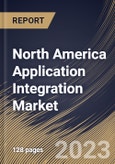The process of making different applications - each created for a different, specific purpose - work together is known as application integration. Through such software, organizations can achieve connections that enhance their infrastructures and enable agile business operations by combining and streamlining workflows and data between various software applications. The gap between the current on-premise system and rapidly expanding cloud-based enterprise apps is filled in part via application integration.
Application integration enables firms to coordinate a range of tasks across their complete infrastructures, allowing them to run more efficiently and effectively. This is done through smoothly networked processes and data exchanges. In contrast to data integration, application integration directly connects various applications at the functional level. As a result, organizations can construct dynamic and highly adaptive applications and services by linking application data in almost real-time.
There is a variety of tried-and-true application integration approaches that can be used individually or in combination. These approaches can vary from the more contemporary API-led integration approach where business IT resources can be exposed and found securely to the more conventional service-oriented architecture (SOA) approach where various applications are integrated via a communication 'bus' between them. This enables businesses to plan integration flows that start up when events in one application trigger actions in another. Enterprises are able to remain flexible by responding to new data flows or performance problems as they arise rather than after the fact, owing to these real-time interactions.
The IT sector has begun to embrace hybrid cloud business technology in North America. The sector where cloud computing solutions are expanding the fastest in North America is healthcare. The focus is on how innovation might be utilized to improve and tailor patient care while cutting costs. Data storage, as well as service, are no longer the only technological advances. The adoption of digital business techniques and the preference of businesses for SaaS-based goods are what is causing it to be so widespread. Hence, the region presents lucrative growth prospects for the growth of the market.
The US market dominated the North America Application Integration Market by Country in 2022 and would continue to be a dominant market till 2029; thereby, achieving a market value of $11,019.3 million by 2029. The Canada market is poised to grow at a CAGR of 21.2% during (2023-2029). Additionally, The Mexico market should witness a CAGR of 20.1% during (2023-2029).
Based on Integration Type, the market is segmented into Integration Platform as a Service, Enterprise Application Integration, Point-To-Point Integration, Hybrid Integration and Enterprise Service Bus. Based on Application, the market is segmented into Enterprise Resource Planning, Customer Relationship Management, Human Resource Management System, Supply Chain Management & Business Intelligence, and Electronic Health Record Management & Others. Based on Offering, the market is segmented into Platforms and Services. Based on Vertical, the market is segmented into BFSI, Retail & eCommerce, Manufacturing, Healthcare & Life Sciences, Energy & Utilities, Automotive, Transportation & Logistics, Government & Public Sector and Others. Based on countries, the market is segmented into U.S., Mexico, Canada, and Rest of North America.
The market research report covers the analysis of key stake holders of the market. Key companies profiled in the report include Fujitsu Limited, Hewlett-Packard Enterprise Company, IBM Corporation, Microsoft Corporation, Salesforce, Inc. (MuleSoft), Oracle Corporation, SAP SE, Software AG, Tibco Software, Inc. (Vista Equity Partners) and Itransition Group.
Scope of the Study
By Integration Type
- Integration Platform as a Service
- Enterprise Application Integration
- Point-To-Point Integration
- Hybrid Integration
- Enterprise Service Bus
By Application
- Enterprise Resource Planning
- Customer Relationship Management
- Human Resource Management System
- Supply Chain Management & Business Intelligence
- Electronic Health Record Management & Others
By Offering
- Platforms
- Services
By Vertical
- BFSI
- Retail & eCommerce
- Manufacturing
- Healthcare & Life Sciences
- Energy & Utilities
- Automotive
- Transportation & Logistics
- Government & Public Sector
- Others
By Country
- US
- Canada
- Mexico
- Rest of North America
Key Market Players
List of Companies Profiled in the Report:
- Fujitsu Limited
- Hewlett-Packard Enterprise Company
- IBM Corporation
- Microsoft Corporation
- Salesforce, Inc. (MuleSoft)
- Oracle Corporation
- SAP SE
- Software AG
- Tibco Software, Inc. (Vista Equity Partners)
- Itransition Group
Unique Offerings
- Exhaustive coverage
- The highest number of Market tables and figures
- Subscription-based model available
- Guaranteed best price
- Assured post sales research support with 10% customization free
Table of Contents
Companies Mentioned
- Fujitsu Limited
- Hewlett-Packard Enterprise Company
- IBM Corporation
- Microsoft Corporation
- Salesforce, Inc. (MuleSoft)
- Oracle Corporation
- SAP SE
- Software AG
- Tibco Software, Inc. (Vista Equity Partners)
- Itransition Group
Methodology

LOADING...








